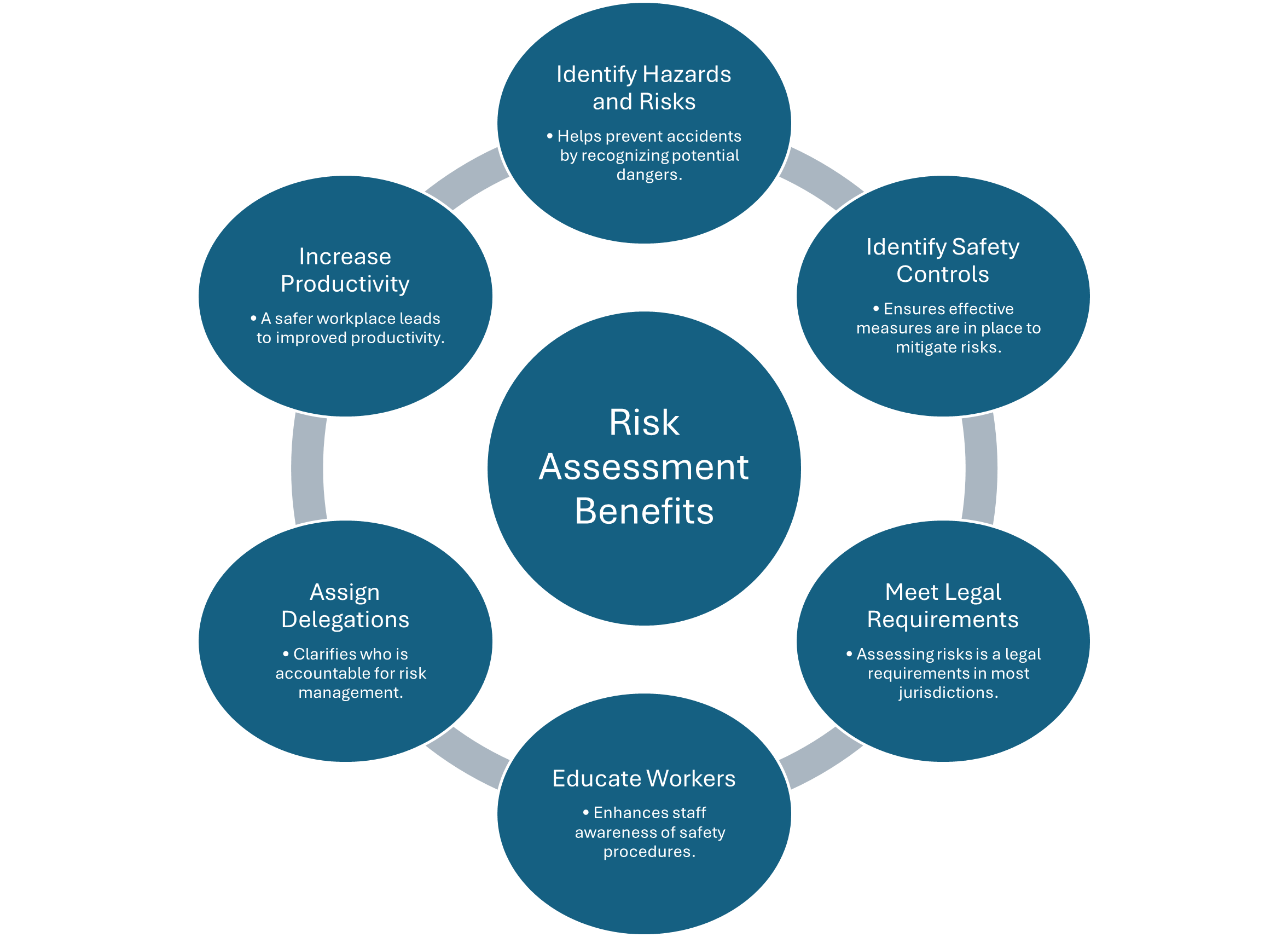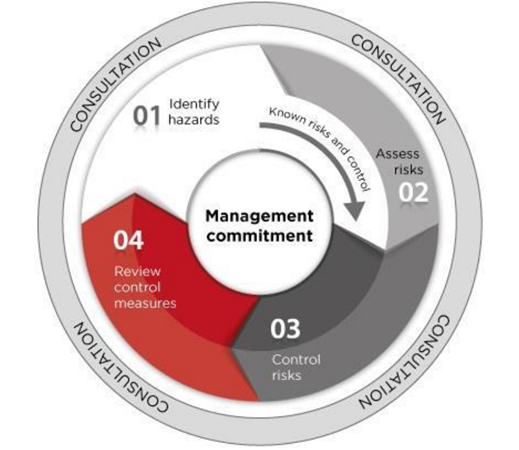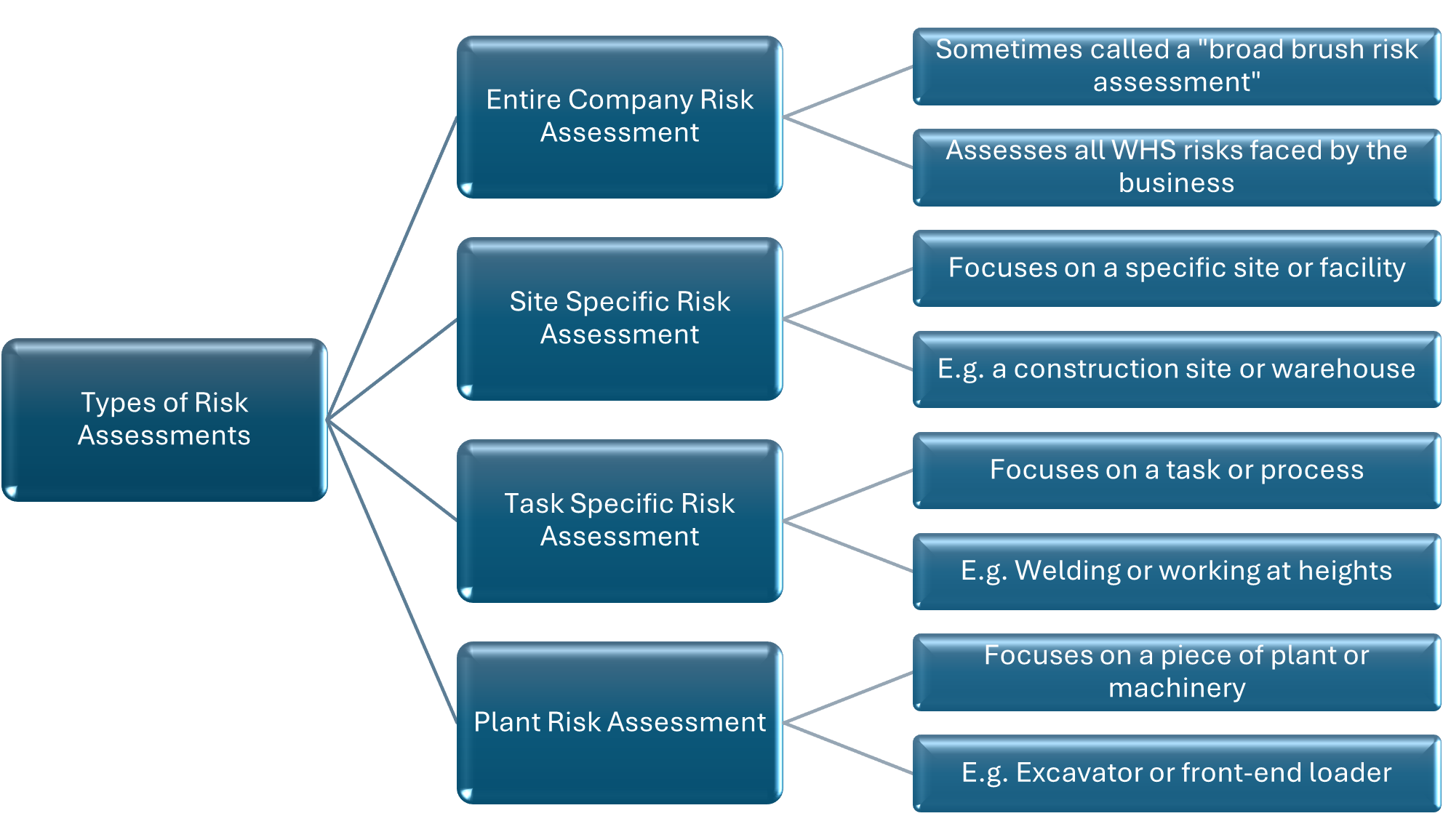Why a WHS Risk Assessment is Important for Your Business
Download our Free Risk Assessment Template
By downloading, you agree to our Free Resources Licensing Agreement:

Keep reading to discover:
- What is a WHS Risk Assessment,
- Why a WHS Risk Assessment is Important, and
- How to Conduct a WHS Risk Assessment (with a video tutorial).
Why is a WHS Risk Assessment Important?
A WHS Risk Assessment can help with the following:
- Identifying hazards and risks: Helps prevent accidents by recognizing potential dangers.
- Identifying safety controls: Ensures effective measures are in place to mitigate risks.
- Meeting legal requirements: Assessing risks is a legal requirements in many situations.
- Educating workers: Enhances staff awareness of safety procedures.
- Assigning responsibility for controls: Clarifies who is accountable for risk management.
- Increase productivity: A safer workplace leads to improved productivity.

A WHS Risk Assessment is an evaluation of potential hazards in your workplace that can lead to injury or illness. A risk assessment helps you identify potential risks, and develop solutions to reduce them as much as possible. It also prompts you to think critically about how your business operates, what tasks are performed in each area of the business, who is permitted access to those areas, and so on.
What is Contained within a WHS Risk Assessment?
A WHS Risk Assessment typically contain:
- The task details (i.e. what task or thing is being assessed). For example:
- Digging a concrete slab
- Operating a forklift
- Installing skylights
- The task steps (i.e. a step-by-step sequential breakdown of the process or task). For example:
- Step 1 – Access site
- Step 2 – Setup equipment
- Step 3 – Perform task
- Step 4 – Packup and clean up
- The hazards or risks (i.e. the things that can hurt people or cause damage / harm). For example:
- Overhead hazards (e.g. powerlines)
- Underground hazards (e.g. buried pipes)
- Plant movement
- The controls (i.e. the things that we do to protect ourselves and others). For example:
- Exclusion zones around plant and powerlines
- Dial before you dig
- High-vis clothing
- The risk scores (i.e. the likelihood and consequence before and after controls are implemented). For example:
- Catastrophic
- High
- Moderate
- Low
- Responsibilities (i.e. who is responsible for implementing the safety controls). For example:
- Workers
- Site supervisor
- Safety officer / advisor
A WHS risk assessment is a process that identifies potential hazards that could lead to an accident or illness. A hazard is anything that poses a risk to people—whether it’s people inside or outside the workplace.
Hazards can be:
- Physical,
- Mechanical,
- Chemical,
- Biological,
- Psychological,
- Ergonomic, or
- A combination of any of these things.
It’s important to identify potential hazards in your workplace because they can be the cause of injury or illness.
Types of WHS Risk Assessment
A WHS Risk Assessment is often conducted as a broad overview of your workplace (sometimes called a broad-brush risk assessment).
Other types of WHS Risk Assessment Include:
- Site Specific: Focuses on one particular location, site or facility. A risk assessment for a specific site is useful for determining what hazards exist at that one location, and what solutions can be put in place to reduce those hazards.
- Task Specific: Focuses on identifying and evaluating potential hazards associated with a particular task or activity.
- Plant Specific: Focuses on identifying hazards related to specific machinery or equipment. This type of assessment evaluates the risks posed by the operation, maintenance, and interaction with the plant or machine.
How to Conduct a WHS Risk Assessment
You can use our free Risk Assessment Template.
Step 1 – Fill in The Details
Fill in:
- The task or thing being assessed,
- Who is doing the assessment, and
- The date.
Step 2 – List the Task Steps
List the task steps in sequential order.
Step 3 – List the Hazards and Risks
List the hazards and risks for each task step.
Step 4 – Score the Initial Risk (with a risk matrix)
Using a risk matrix, score the initial risk (i.e. the risk before any safety controls have been implemented)
Step 5 – List the Safety Controls
List the safety controls, i.e. the things that we will do to keep ourselves (and others) safe.
Step 6 – Score the Residual Risk (with a risk matrix)
Using a risk matrix, score the residual risk (i.e. the risk after safety controls have been implemented).
Step 7 – List the Person/s Responsible
List the person/s responsible for implementing the safety controls
Step 8 Colour the Cells
Beautify your risk assessment by colouring the risk cells with the corresponding colour from the risk matrix.
Is a WHS Risk Assessment a Legal Requirement?
You may think the answer is “Yes”. However, its more complicated than that.
There are specific regulations that state a risk assessment must be completed, for example:
- Confined space risk assessment – (WHS Regulations s(66) Managing risks to health and safety)
In general, risk assessments assist in the risk management process, which is outlined within WHS Regulations Part 3.1 – however “risk assessments” are not specifically mentioned in Part 3.1.
The code of practice “How to manage work health and safety risks” describes the 4 step risk management process where step 2 is to assess risks.

The code states that a risk assessment should be done when:
- there is uncertainty about how a hazard may result in injury or illness, or
- the work activity involves a number of different hazards and there is a lack of understanding about how the hazards may interact with each other to produce new or greater risks, or
- changes at the workplace occur that may impact on the effectiveness of control measures.
The code also states that in some circumstances, a risk assessment will assist to:
- identify which workers are at risk of exposure,
- determine what sources and processes are causing the risk,
- identify if and what kind of control measures should be implemented, and
- check the effectiveness of existing control measures.
Protect your Business from Liability
If you conduct a workplace health and safety risk assessment and identify hazards, it may be easier to avoid liability. Since you’ve identified the hazard, you’ll know what to do to control it. If there is an accident or illness, you can show that you’ve taken steps to avoid the hazard. You can read more about the penalties and costs of non-compliance in our article What are the WHS Penalties for Non-Compliance?
Improve Productivity for Employees
A risk assessment can identify aspects of your business that could be improved to reduce the risk of workplace injuries and illnesses. This might be something as simple as a poorly placed drainage grate that could cause someone to trip and fall. A risk assessment can help you identify ways to improve the way your business operates, which can help your employees to be more productive.
There may even be ways to improve productivity through simple changes, like switching to a safer chemical for cleaning your products. This could be more effective than the chemical your business currently uses, while also reducing the risk of injury.
Articles and Further Reading
- Identify, assess and control hazards – Managing risks (Safe Work Australia) <https://www.safeworkaustralia.gov.au/safety-topic/managing-health-and-safety/identify-assess-and-control-hazards/managing-risks>
- A Comprehensive Guide To Safe Work Method Statements (Spire Safety) <https://spiresafety.com.au/resources/safe-work-method-statements/>
- Key WHS Requirements for Construction Site Safety (Spire Safety) <https://spiresafety.com.au/resources/requirements-construction-site-safety/>
If you want help conducting a WHS risk assessment in your workplace or any other assistance contact us.

